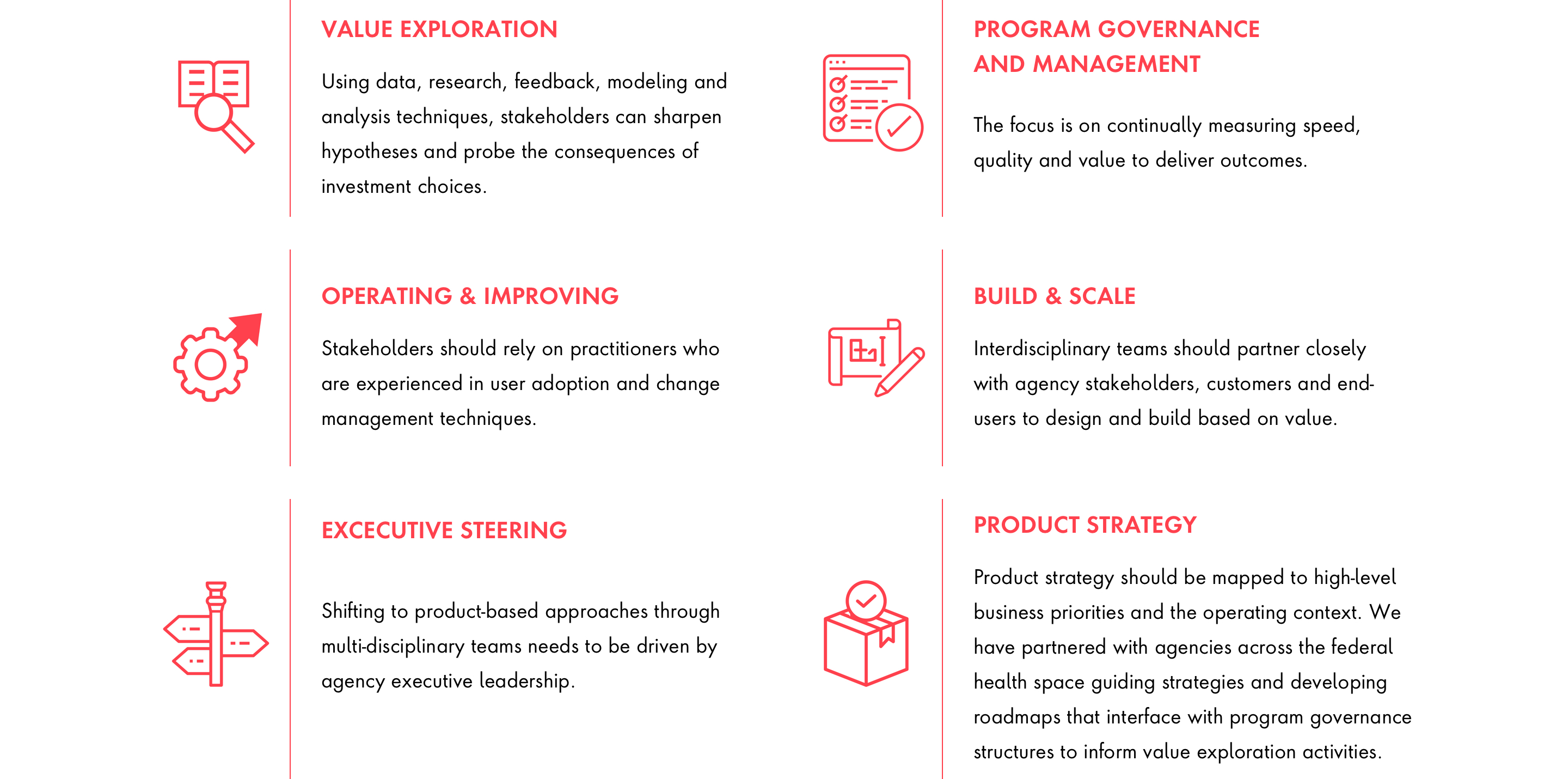What issue can we solve for you?
Type in your prompt above or try one of these suggestions
Suggested Prompt



Public Sector
Product Management: Seizing Opportunity and Value Across the Public Sector
Product Management: Seizing Opportunity and Value Across the Public Sector
Product management in a digital age allows federal agencies to pivot strategically and increase speed to market for new capabilities.
Product management: Begin with the mindset
Product management and project management are often confused. The product concept shifts project thinking from, “Are we building the solution right?” to “Are we building the right solution?”. Digital project management often starts with a set of requirements for a discrete implementation effort, while product management starts with away of thinking and a management model that prioritizes and organizes around the goal of achieving value. Digital products deliver value to users through software-based services and experiences.
Product management requires a holistic and focused perspective, constantly questioning how a solution can better support the agency’s mission and providing engaging experiences for end users.
In addition, while specific tenets of product thinking may vary, the goal is the same: to rapidly create and evolve experiences that best accomplishes stakeholders’ needs and encourages repeated interactions. Product management can help achieve digital transformation.
A new framework for transformation
Across the federal government and commercial industries, many large digital initiatives fail under their own weight. Many are burdened by the complexity of requirements and analyses for set enterprise projects, which come with set budgets. As the macro-environment changes, a rigid project mindset provides little opportunity to reconsider program or portfolio solutions. Many federal projects, with thousands of requirements, have wasted time and resources hyper-analyzing and decomposing every detail, instead of prioritizing and recalibrating efforts across rapid iterations. Establishing products and processes to forge organizational, integrated routes to value is often the most strategic approach to rapidly responding to emerging customer needs.

A partner that can help agencies tackle large, ambitious initiatives with the ability to adapt to change and operationalize solutions across the cultural fabric of an organization will distinguish themselves from their competition. Partners that focus on results from time (level of effort) and costs invested are best equipped to deliver optimal value. In an era that requires entities to fail fast and learn fast, design thinking principles and an agile approach are mandatory for any agency. This approach enhances the traditional project management “iron triangle” from managing scope, schedule and cost toquality, speed and value as the new dimensions of performance.
Digital transformation requires adaptive frameworks to chart meaningful work from concept through completion, at scale. To address enterprise digital challenges, new frameworks must be strategic, flexible, nimble and intuitive in order to support change.
How to excel
Product-based digital transformations require the right mindset and culture of the organization leading the work. Digital product management is successful when supported through digital strategies and governance, deployed via proven methodologies, such as lean startup and integrated product roadmap development, aligned to industry best practices.

For federal digital transformation, starting with the right foundationis critical. The priority should be to achieve value, which can be defined as how federal and public needs are met relative to the cost and time invested. How can an agency’s mission and customer needs be realigned with the strategy, experiences, technologies and data necessary to deliver value?
Additional questions to consider include:
- What specific products best demonstrate the organization’s desired outcomes, business value and are deserving of strategic focus?
- How will the agency and its partners organize and align around value?
- What systematic mechanisms are in place to test product ideas and hypotheses and gather evidence incrementally with fast, integrated learning cycles?
- How will meaningful and specific outcomes (such as user experience satisfaction and increased business function processing) be identified and measured to help the agency look beyond outputs?
- What will allow the agency to maintain compliance and performance while it undergoes business and technology change?
- What is the organization’s current agile and development-security-operations (devsecops) maturity, and how can it progress forward?
Product management considers the core elements of each project beyond fulfillment of written contractual requirements. It explores what is possible through the powers of collaboration, creativity and individual ideas. By developing a self-motivating system driven by engaged team members who are focused on achieving impact, product management can deliver contractual outputs as well as higher-value outcomes.
An integrated product strategy identifies the highest priority efforts that drive value across stakeholder communities.
Where typical federal governance through integrated product teams (IPTs), working groups, program management offices and other executive forums help to shape strategic priorities and focus investments, a product orientation helps to organize contributors around opportunities to achieve the most value for an organization and its customers. It also more readily identifies new opportunities to build tools and capabilities that drive strategic advancement.
When exploring product management in support of product delivery, federal agencies and their partners should consider:

Interdisciplinary teams should partner closely with agency stakeholders, customers and end-users to design and build based on value.
At Publicis Sapient, we are helping organizations like leading financial services institutions and federal clients incrementally shift from a project mindset to a product mindset.
To learn more about how our leading Product Management practices can help your agency get more from your investments, contact Stephen Goldstein, Snr Director.




